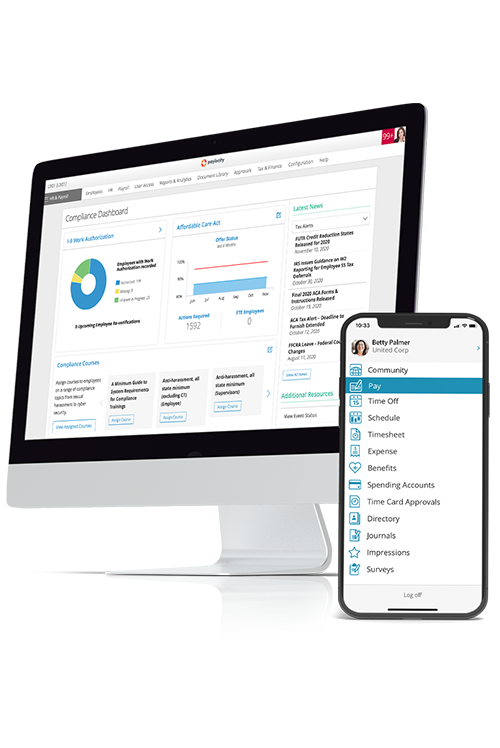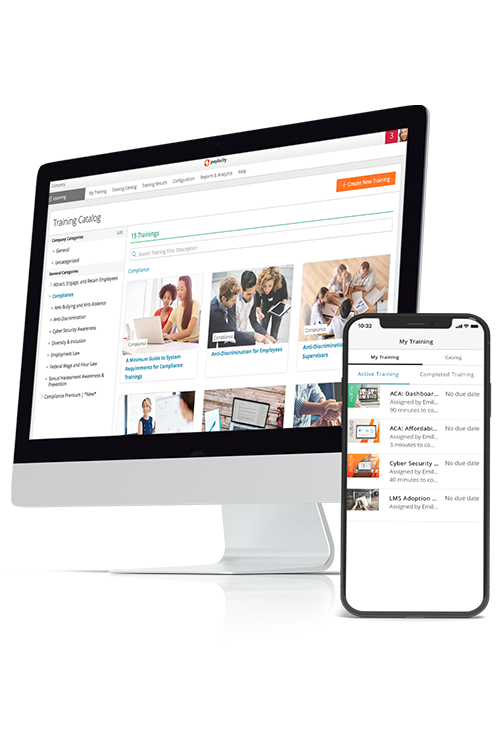resources
Microlearning: How to Ensure Your Employees Train and Retain
July 27, 2023
Microlearning allows employees to learn by watching and interacting with short pieces of information at their convenience. Learn why this strategy should be a part of every HR pro’s toolkit.
Blog Post

In a world where attention spans are fleeting, and the smartphone is king, traditional teaching methods aren’t always the most effective ways to get people to learn.
So, how can organizations make sure their employees are learning what they need to? How can they help customers understand how to use their products if that audience can’t spare more than a few minutes to find out?
Businesses need to keep things short, sharp, and to the point.
And that is where microlearning comes in.
Microlearning allows employees to learn by watching and interacting with short pieces of information on mobile devices at their convenience. It can make all the difference in your learning and development programs, whether you’re helping employees earn their degrees or building on existing knowledge.
Let’s dive into what microlearning is, its benefits to learners, and how to implement this type of content at your organization.
What is Microlearning?
Whether it’s driving a truck, learning to code, or getting good at poker, it’s rare we learn everything we need to about a new subject or skill in one fell swoop.
In fact, it’s almost always much more effective to have information drip-fed to us rather than trying to down the entire knowledge bottle in one go.
Microlearning is an educational method that uses bite-sized content to teach the learner a specific skill or function. It only requires the learner’s attention for short periods of time with the aim of having them grasp the subject in stages.
What types of microlearning content can you use?
Microlearning content comes in many forms and is usually hyper-focused on a particular subject. Useful microlearning tools include:
- Videos
- Audio (e.g., podcasts)
- eLearning
- Blogs
- Articles
- Interactive games
Basically, any type of content that can be punchy and informative for one to 15 minutes can work.
When can you use microlearning?
Microlearning is like a Swiss Army Knife: useful in a variety of situations, and something you may regret not having when you need it.
Here are a few situations where your organization can make the most of microlearning.
Onboarding
Instead of bombarding your new members of staff with a stack of papers on company protocol, why not use microlearning to ease them in with a more manageable approach? Break down the onboarding process into small, bite-sized chunks for a smoother onboarding experience.
Employee development
Employees are hungry for professional development, but don't always have the time to devote hours to long-winded courses to learn new skills.
This is where having a stockpile of short and sweet development resources on tap comes in handy. When your employees can invest in their development at their own convenience, they're more likely to jump at the chance.
Compliance training
Compliance training may not be the most thrilling activity, but in many industries, it's necessary to stay in business.
So, making compliance training feel like less of a chore and ensuring your people don't lose interest is crucial. You don't want to invite any risk to your business because your employees didn't pay attention to something vital.
Microlearning is the perfect solution here. It breaks up heavy chunks of information into digestible pieces and ensures a far better rate of learning retention.
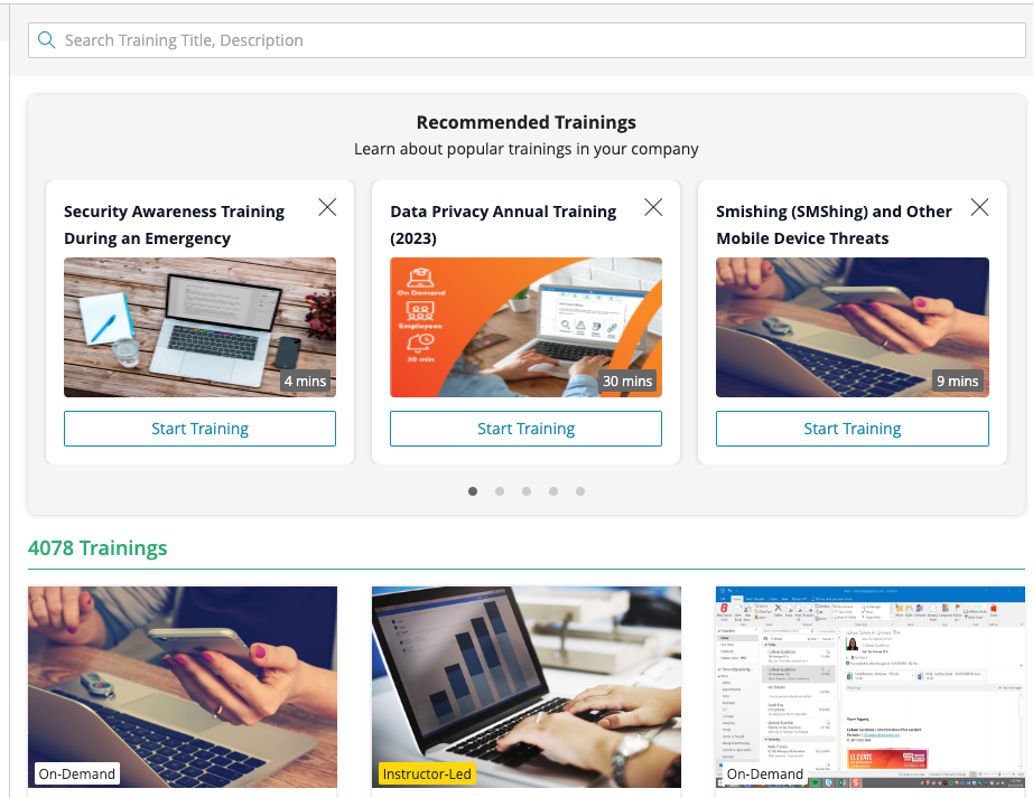 A learning management system can house thousands of courses, ranging from short on-demand lessons to longer instructor led classes.
A learning management system can house thousands of courses, ranging from short on-demand lessons to longer instructor led classes.
What Are The Benefits of Microlearning?
Now that we understand what microlearning is and how to use it, let’s look at the advantages it can offer your company.
Better information retention
Have you ever attended an hours-long meeting, only to forget everything that you’ve heard once you walk out the door?
Don’t worry, it’s not just you. Our brains aren’t as effective at remembering information when it’s introduced over a single longer interval. On the contrary, a whole body of research supports that retention improves when learners engage with material in shorter bursts over time.
Microlearning works with your brain’s wiring. That means snackable lessons make it easier for employees to remember what they’re learning.
Less time-consuming for learners
Microlearning is meant to be brief, and the benefits are two-fold. On the one hand, your employees can take less time out of their day for learning, and on the other hand, they’ll be more likely to engage because it takes less time. A win-win!
Fast turnaround
The turnaround from the development of microlearning content to deployment is fast. You can produce microlearning videos for basic concepts within mere hours.
With specialist software, developing effective and engaging micro e-learning content is even more straightforward. Some learning management systems come preloaded with professional training content so you can hit the ground running.
Accessible
Micro e-learning is accessible on a range of devices, provided you use a mobile-friendly platform. Employees can easily choose to watch a video or complete a course on the go at their convenience, whether that’s on a commute, waiting to drive their kid’s carpool, or when their tray is clear towards the end of the day.
User-friendly reference library
Microlearning content often lives in a digital library that’s accessible to your workforce on-demand. This serves as an excellent repository that employees can reference to troubleshoot an issue or answer a question.
Simply rewatch a video or micro-course to get up to speed in a snap. A user-friendly searchable learning management system makes it easy for employees to find the answer on their own.
The main benefit here is the productivity boost. After a quick refresh, employees can work on the task rather than hesitating while trying to remember how to do it, or worse, doing it incorrectly.
Improved learner engagement
It’s easy to lose track of time when you’re binge-watching a TV show or boxset. But outside a "Lord of the Rings" marathon, watching several different movies back-to-back isn’t often the done thing. It’s just so much harder to keep your concentration across a longer timeframe.
It’s harder to engage with than traditional long-form learning, where learners can lose interest or become distracted due to mental fatigue. By keeping content focused, you’re not asking learners to concentrate for longer than they can manage, and what you teach them will stick.
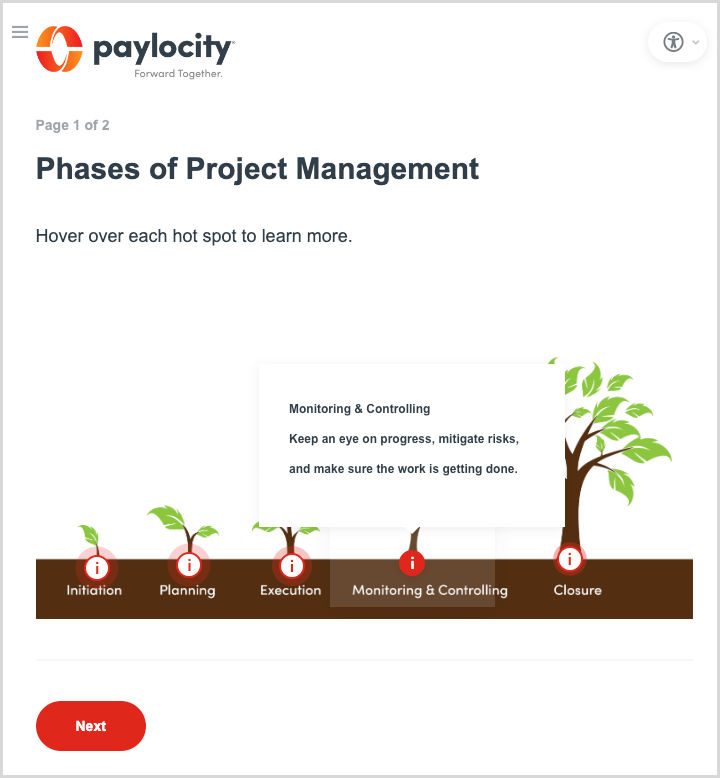 This project management course uses illustration and interactivity to allow learners to tackle concepts at their own pace.
This project management course uses illustration and interactivity to allow learners to tackle concepts at their own pace.
Examples of Microlearning Formats
Now, let’s look at some examples of microlearning content that you can use as a source of inspiration when you develop your own strategy.
Video content
If the reaction to our high-school teachers wheeling out the television set in class has taught us anything, it’s that few things are more effective at keeping people engaged than video.
Microlearning video content can be delivered in a few different ways:
- Demonstrations: You can learn many skills by simply watching someone else do it first. This type of video content can be especially helpful for onboarding new hires or training your existing workforce on a new system.
- Short lectures: Compliance learning usually doesn’t require a practical demonstration. The aim here is to get the learner to understand the rules and the part they play in following them, so even a brief video can get the vital information across There’s no need to go into great detail.
- Animation: Simple, clean animations can help with knowledge retention. Animators have complete control over what the viewer can see. This means they can eliminate any distractions and keep content focused.
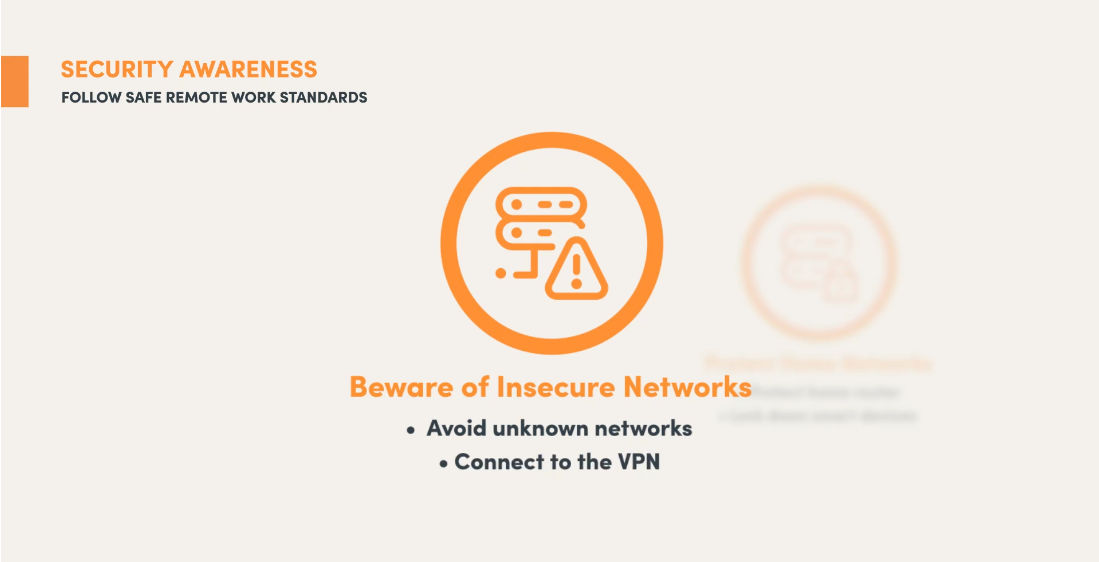 Paylocity uses animation in cybersecurity training videos to quickly and succinctly convey ideas.
Paylocity uses animation in cybersecurity training videos to quickly and succinctly convey ideas.
Games, tests, & quizzes
A fantastic way to boost engagement with learning is through interactive content. Gamification is a buzzword, but it simply means learners can interact with content and have a little fun at the same time. It can bring a sense of enjoyment to the overall employee experience:
- Games: Minigames can enhance micro e-learning modules. For learning centered on memorization, you could feature flashcards, for example. A drag-and-drop mini-game may be effective for course consumers learning about sorting. Games can also be a way of virtually practicing a task for which equipment is required. This is useful if real equipment is unavailable for training.
- Tests: Knowledge checks let you and the learner know they’ve grasped the content. A short test at the end of an e-learning module is all that’s required. If you find learners are failing often, it may mean the micro-course needs tweaking.
- Quiz-as-you-go: You could place quiz questions throughout a microlearning course. After they’re done reading a slide or watching a short video, ask about what they just learned. It helps to punctuate the content and highlight the importance of a key bit of information.
Written content
Short-form written instruction can be useful, too. Blogs, infographics, or articles can all be microlearning content. In fact, this very article could be considered microlearning. It doesn’t take that long to read, it's educational, and it’s fun (we hope!)
Micro-coaching
Sometimes, face-to-face learning is required no matter what. But you can still apply a microlearning approach to in-person learning. Keep sessions short or break them up with learner participation or tasks.
Microlearning Best Practices for Your Organization
We’ve established that microlearning can improve efficiency and productivity, but that depends on you approaching it in the right way. Let’s take a look at some of the best practices when deploying microlearning at your company.
Establish business goals
Ask yourself what you’re trying to achieve and how microlearning can be a part of that:
- Is your team grappling with a skills gap?
- Are you looking for ways to boost productivity?
- Do you need to improve compliance at your company?
Answering questions like these first will help you determine how microlearning can fit into your training regime and build an effective microlearning strategy.
Apply microlearning to micro-skills
Microlearning strategies aren’t suitable in every case. No one’s going to become a doctor by taking microlearning courses. It’s best deployed to gradually build up skills over time.
For employee development, you can divide a role into a series of micro-skills. The learner can build their skill set at a pace with which both you and they are comfortable. Over time, they’ll gain the skills they need to be effective in their role.
Use a variety of content
Microlearning positively influences engagement, so double down on that with a multi-modal microlearning experience.
In other words, use different kinds of content to keep things fresh. Don’t just use microlearning videos, gamified content, or written materials, but a combination of all three for each subject.
Quality over quantity
Fail to make high-quality microlearning content and you risk losing the benefits of engagement and knowledge retention. Having volumes of middling to poor content defeats the whole point. Invest in quality to reap the full benefits of microlearning.
Ensure accessibility
There are a variety of microlearning platforms you can choose from, but it’s vital that you choose one that emphasizes accessibility and convenience. Look for a learning platform that allows employees to access training on-demand from any device.
Microlearning in Business: Empower your employees
If this article was written as a big block of text rather than being divided into sections and bullet points, we’d wager you wouldn’t be reading this conclusion right now. To be honest, we wouldn’t have blamed you!
But, by applying the principles of microlearning, you were able to absorb it in manageable pieces and retain the important information. If you adopt this method in your training practices, you and your employees will reap the same benefits.
To truly get the most out of microlearning, leverage a digital learning management system (LMS) to house your coursework. Paylocity’s LMS is designed for employers and employees, and makes embracing microlearning easy with features like:
- A massive library of training content, including compliance and HR certification courses.
- Create custom curriculum and import existing coursework files.
- Automate training assignments, track employee progress, and send reminders.
- Learning on-the-go through the Paylocity mobile app.
Want to learn more? Request a demo today!
